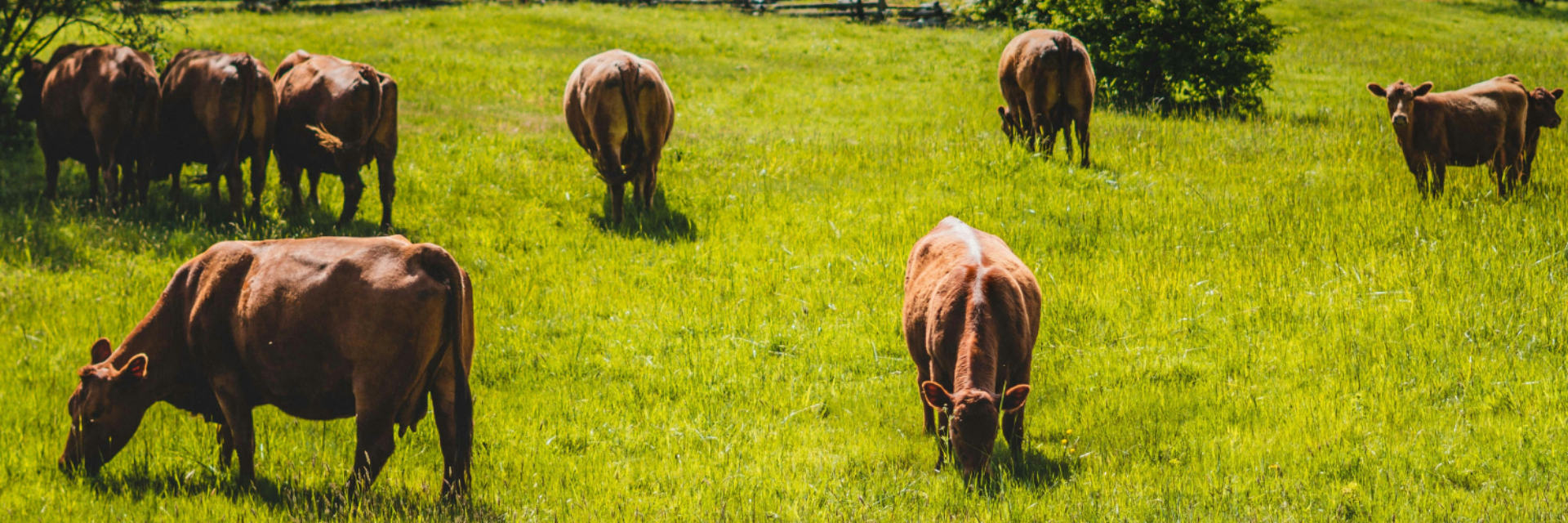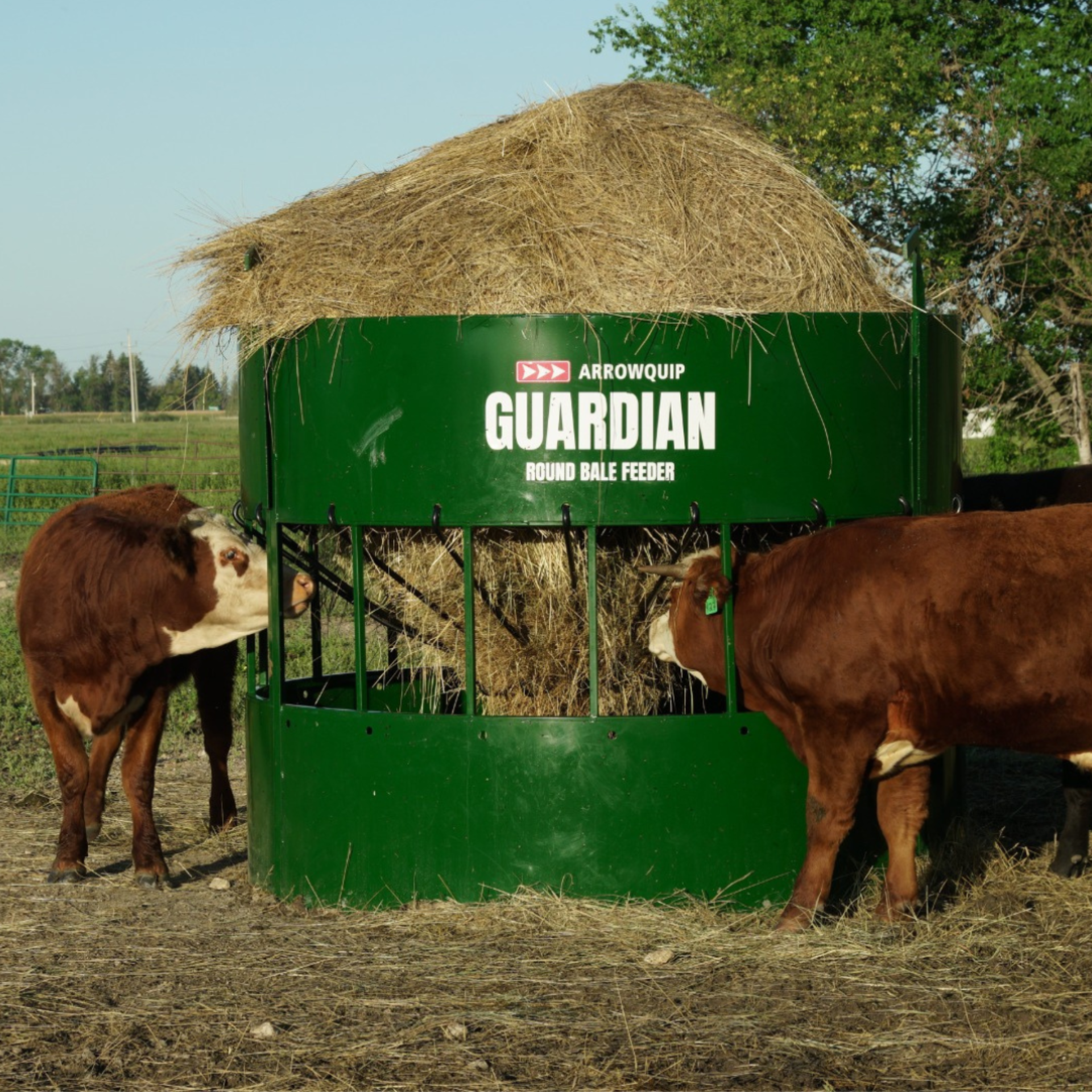Selecting the Right Cattle Feed Plans

Did you know that what you feed your beef cattle directly affects the quality of the meat, the marbling of the fat, and the overall price at market? Having a solid plan for feeding beef cattle that considers nutritional needs, cost and availability of feed, as well as other aspects of feeding your livestock can improve the quality of the final product, therefore improving your farm profits.
Cattle Feed Plans: What Do Beef Cattle Need to Eat?
All types of cattle are born with a four-chamber stomach. At birth, calves live off the fat and protein that comes from their mother’s milk, and their stomach functions more similarly to a single-chamber stomach. As calves get older and begin to eat grass and forage, the other three stomach chambers grow to become one of the most efficient means of transforming plants into protein.
Cattle are very efficient at extracting as much nutrients as they can from the food they eat. Ruminants have a special stomach chamber filled with microorganisms that break down the components of their food. However, cattle still need specific nutrients to grow and thrive such as:
- Protein: While hay and various grasses contain protein, most cattle will get their protein through legumes. Soybeans are the most common protein source, followed by cottonseed meal and linseed. They can also get protein sources from mineral blocks, which is especially helpful for young calves.
- Minerals: Cattle can get minerals through the hay they eat, though the amount can vary depending on mineral content in soils where the hay is grown. Livestock need calcium, phosphorus, potassium, and salt as the basic minerals, but trace amounts of iodine, copper, cobalt, zinc, and selenium are also essential. To ensure your cattle get the proper minerals, it’s important to feed them minerals – whether in block form, or loose – so they stay healthy.
- Vitamins: Minerals for cattle are only half of the equation. They also need an abundance of vitamins A, D, and E. Bacteria that lives in the fourth stomach produce vitamins K and B, so you don’t have to worry as much about feeding your cattle these vitamins.
Importance of Good Pasture
The better your pastures, the less supplements you’ll need to give your cattle as they’ll be able to get most of their nutrients straight from the forage they’re eating. Pasture grass is both high in vitamins and roughage – two important components necessary for cattle health.
Though grass-fed cattle can be more labor intensive, consumers are willing to pay a higher price for grass-fed meats. To some, the taste may be different, providing consumers with a sense of gourmet flavor and an exclusive beef product they will pay premium for. Good pasture maintenance includes:
- Ensuring the right seed mixture is used to produce grass that is high in minerals and nutrients for optimal nutritional value. You can also place mineral feeders in the pasture filled with additional vitamins and minerals to ensure your cattle are receiving the nutrients they need.
- Resting, reseeding, raking, and cutting pastures when necessary. You can also spread manure through the pasture to help the grass grow.
- Checking for weeds that will reduce nutritional value and/or poison cattle. Some weeds are merely a nuisance, whereas others, such as Jimsonweed, White Snake Weed, and Water Hemlock.
- Ensuring gates and fences are up-to-date, and there are no holes that allow cattle to escape. The last thing any rancher wants is their livestock to be missing or injured, so keep those chances lower by making sure your equipment is in top condition.
Water: The Forgotten Nutrient
One crucial thing you cannot forget when raising livestock is water. Although it’s not often considered a part of cattle feeding plans, it is a critical part of a proper cattle management plan. All animals need access to fresh, clean water every day.
Did you know that cattle drink between three and 30 gallons of water a day during cold weather? During hot weather, their water needs increase drastically – so much so, they may need to drink one gallon of water for every 100 pounds of body weight at least once a day.
If watering your cattle using a trough, it’s important to monitor the condition of the water and keep it clean as algae can develop, or cattle may drop manure into the trough. It’s important to note that galvanized steel is easier to clean compared to other options.
Ponds, streams, and dugouts are other options when it comes to water supply for your cattle, though it’s important to still monitor the conditions of the waters. If your cattle are turned out near a stream, always ensure your fence extends over the stream so they can’t walk downstream and right out of your pasture. On a hot day, cattle will cross running water and wade on a hot day.
Managing a Feeding Calendar: Reducing Hay and Feed Costs
Raising livestock for profit can be a risky venture. Sometimes you make money, but if the market prices for cattle drop, you may lose money. One way to maximize profits is to properly manage your feeding calendar against your pasture and forage crops.
The more you can grow your own feed, the better off your operation will be. Raising your own bend of hay helps you control both quality and costs, though some years you may need to purchase additional hay to supplement what you’ve been able to grow on your own.
Some producers may not have adequate land or capital to grow the hay or grain they need to raise cattle. For those who must rely on purchasing externally, buying in bulk and properly storing feed will help save costs. To ensure your hay bales last and you get the most out of your money, it is recommended to invest in a few round bale feeders that are designed to drastically reduce waste.
Arrowquip offers the very best in cattle equipment to help you manage your operation including feeding equipment, manual and hydraulic squeeze chutes, and cattle handling systems. We’ve chosen equipment that can stand up to your toughest ranch chores, built durable, safe, and efficient.
Contact us today for the right equipment to keep your herd happy and healthy.





Comments
Join the Discussion
Comments
I have an 18 acre place and two Angus calves. I would like to feed them out to butcher. They are 8 months old now. My pastures are good with side oats grama and kline grass.
A friend said starting with horse and mule feed first then regulating the protein and carbohydrates is best to get good tasting meat. I have heard 8% protein and then corn or sorghum or soybeans. I know these have to be cracked to allow the animal to digest the grain.
What is your best plan for the cheapest feed but best tasting meat?
For any feeding plan, we recommend connecting with your vet or a livestock nutritionist. However, when it comes to feeding your livestock, balance is key. Cracked or rolled grain is easier for cattle to digest and will make your feed go further. We recommend reviewing the tips here as well:
https://arrowquip.com/blog/animal-science/best-healthy-feed-beef-cattle/
It was helpful when you explained how a well-thought-out plan for feeding beef cattle that consider their dietary requirements, the price and supply of feed, as well as other feeding beef cattle-related factors, can increase farm profits by raising the caliber of the finished product.
More informative than any other site I've seen so far. Still sad and gross that we feel this is still necessary on the large scale. When it is so far removed from our existence, it becomes neglected, expected and unearned. I do seriously respect those of you killing your
own animals for family/community consumption, but most of the people who consume meat everyday will never have to castrate, raise, slaughter, gut, bleed, skin or
butcher any animal in their lifetime. These are experiences i feel everyone who eats animals should have to go through anytime they want new meat. And, if you don't want the hassle of it, then eat kale!
Informative and much appreciated.
Thank you, this site was very helpful in informing me what I should feed my cows. I look forward to reading more information from you.
Thank you